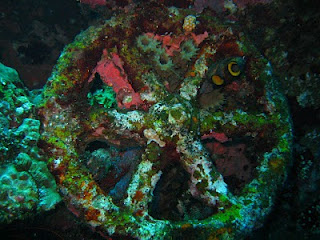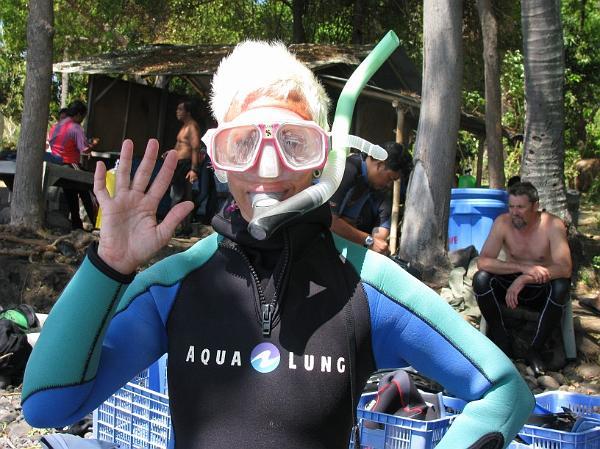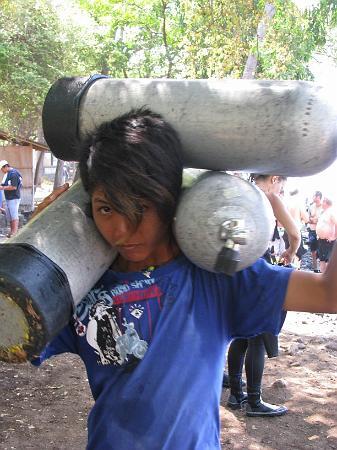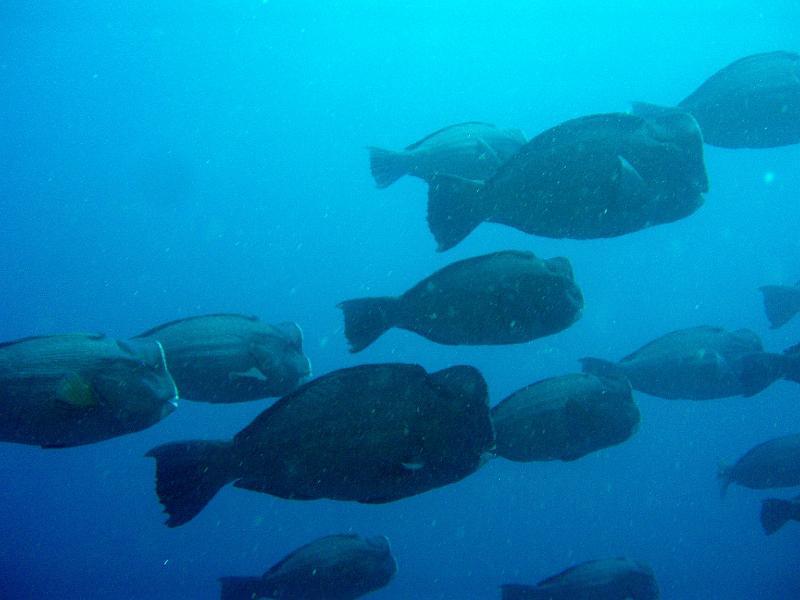The USAT Liberty shipwreck is one of Bali’s most famous, most popular and most accessible dive sites. It’s so popular, in fact, that almost daily the site and nearby Tulamben shore are packed with divers who’ve driven up to Tulamben with dive shops from all over Bali: from Kuta, Sanur, Padang Bai and Candidasa in the south and from the local dive shops in the Amed area, where the wreck is located.
Several factors account for this site’s overwhelming popularity and fame. First off, it’s an extremely easily accessed wreck as it sits just 20-30 M offshore. Divers simply put on their gear, walk into the sea, and they’re already practically on top of the site! For a wreck, especially, this is quite unusual, since most wrecks are located far from land and usually in fairly deep to very deep waters. The USAT Liberty, in contrast, practically peaks it’s head out of the sea at just 3M below the surface, at its most shallow point, and reaches a depth of just 30M at its deepest. This makes it a wreck site that even beginning divers can- and do-visit!
Secondly, and more notably, the ship is an exceedingly beautiful dive site- to the extent that world-reknowned underwater photographers regularly visit to photograph its many charms. The ship itself, at 120 M in length, presents a multitude of fantastic sillouettes because of its many windows, rooms and ship details. In addition, its covered in beautiful hard corals, soft corals, seafans, sponges and hydroids. And its swarming with a huge variety of colorful tropical fish life. As if that’s not enough, the Liberty also has a few special ‘residents’, any of which, alone would make a great dive site. There’s a school of bumphead parrotfish, about 1 M each in length, that often patrol the ship, especially at night. There’s the 1.5 M barracuda ‘security guard’. And there’s the amazing school of 1000 jacks funneling and/or swarming the ship on most days! So, take your pick: interesting ship, beautiful corals, abundant colorful reef fish, or special residents… This site is more like 4 or 5 great sites packed into one!!
Arriving at the site with an Amed area dive shop offers a special treat: yrpedoedou get to dive before the crowds arrive! My shop generally arrives about 9:30, sets up and gets diving underway by 10:00. Since most south Bali shops arrive around 10:30 and get in the water about 11:00, we’re pretty much finishing up our first dive before the others even get started! That makes for a very pleasant, uncrowded dive! In contrast, dives in midday entail navigating around other dive groups of varying underwater ability, including a lot of first-time divers! A bit tricky at times… but still worth the effort.
In any event, what’s the dive like? Let me start with a brief and interesting historical background… The USAT Liberty was a cargo ship that was torpedoed in 1942 by a Japanese submarine in the channel between Bali and Lombok islands. Two US ships managed to tow it to the north coast of Bali, reaching Tulamben before they had to abandon it beachside. They intended to return for its cargo but, due to the escalating war, never made it back. So the Liberty sat on rocky Tulamben beach for 21 years until, in 1963, nearby Mt. Agung, Bali’s sacred volcanic mountain, blew its stack, reeking havoc, spewing lava down to Tulamben, and pushing the Liberty into the sea! The ship was pushed out just over the edge of the sandy coastal shelf. And there it has sat for 25 years, to date, growing corals and gathering tropical life which has resulted in today’s astounding dive site! Lucky for us divers!!
The ship sits parallel to shore, as mentioned above, in 3- 30 M of water. It’s pretty broken up, though both stern and bow are fairly intact, and you can find all sorts of ship features such as guns, portholes, ‘wheel’ latches, rooms and windows, all covered in colorful corals. To me, the most amazing aspect of the site is the ship’s sillouette with its windows and rooms… so on to the dive!
The Tulamben ‘beach’ is actually a stone beach, full of oval fist-sized black and charcoal-colored stones. While they are quite attractive, they make sea entries and exits rather difficult! The stones shift and slide around. The sea is surging in and out. And on some days, waves are breaking on shore. Divers, burdened with full dive gear, have a kind of tricky time getting in an out! In fact, the entry and exit are the most challenging part of the dive! Once you’re in, it’s a breeze! I have found a great and easy technique to make these entries more successful: simply hold on to your dive buddy getting in and out! That way,everyone’s much more stable. Easy…
I usually surface swim out to just before the bottom drops off. There the stones give way to sand and the depth is about 5-7 M. Descending there, it’s a mere 2-5 minute swim over sand to reach the ship’s stern, just enough time for most divers to get stablized underwater and relax… Approaching the ship, first there’s an indefinate dark area looming ahead. Getting closer I can suddenly make out the stern end, rising straight up almost to the surface- a vertical wall of soft and hard corals, hydroids, sponges, shells and the like. To the left is a horizontal slab of the ship, resting against the sandy slope, and with a large hole, allowing sunlight to stream in below it. Cool sight!
Following the ‘wall’ of the stern around to the outer side, I round the corner to see the length of the ship stretching away into the distance. There I get my first glimpse of the ship’s many windows, looking like cutouts in the sea, in the tall vertical stern wall. Swimming along at about 12 M I can glimpse into a couple of large rooms, viewing the ship’s structure. From there it’s a short swim over sand that has covered a bit of the ship then along a beam? wall? of the ship poking up from the sand…
Passing various ship structures on either side then dropping down to about 16-18 M I can glide past a vast room filled, of course, with water, its beams reaching up to toward the surface. Sometimes I enter this vast room, which is mostly open to the surface, gazing around in awe, then swim back out one of the many large openings… There are several large ‘windows’ on 2 sides of this room, through which to peak inside. Cool!
Continuing on are 2 more of my favorite sections. One is a shorter vertical wall showcasing really huge pale orange sefans, about 3 M in diameter- much bigger than me! The other is the ship’s bow. The outer end has a vertical ‘scaffolding’ covered in hard and soft corals that I can swim around, swim through at various depths, swim over for a bird’s eye view downward into the ‘scaffolding’. Up there, at about 18 M is a large barrel sponge standing ‘guard’. The ‘inner wall’ of the bow showcases more large seafans of various types. The ‘outer wall’ slopes steeply from 10 M to 28 M and is covered in feathery fire corals, small sponges, soft corals and hydroids. It’s a pretty cool structure from all sides and I could easily spend an entire dive just exploring the bow at various depths from 30M up to 10 M.
But generally I’m guiding less- experienced divers so I just circle the bow once and head back to retrace the ship at a shallower depth. There’s still lots to see! For instance, at 8-12 M the ‘vast room’ I explored earlier, has a ‘ceiling’ with a large ‘skylight’ opening- another great view of the room or another chance to swim through. At the opposite side, the room is completely open to the surface. From there, I can swim out and slightly up and over the top of a slab of ship, looking down into small cutouts. Nearby there are 2 large drum-shaped areas of ship.
Heading back to the stern, I generally rise up to 10 or 12 M to swim past a layer of windows, peering inside to watch the fish and more colorful corals. I like to swim completely around the stern to the far end, swim out away from the ship a bit in order to gaze back at the tall vertical wall from a distance, then swim around to the more shallow slope side. On the sandy slope next to the stern there’s a ‘field’ of finger-sized garden eels peeking up out of hte sand. Swimming around to the stern’s inner side, I swim over top of 2 rooms, looking downward, then re-circle the stern at about 8 M, where I can gaze into yet more windows, the ship’s mysterious dark inner rooms…
If air and time allow I’ll quite happily continue re-circling the stern, each time more shallow, each time getting new perspectives and gazing into yet more windows. When possible, I even greatly enjoy doing my safety stop at 5 M, where 2 convenient little windows allow me to get ever-changing ‘cut out’ views of the passing fish life and divers.
One fun aspect of a busy dive site is the chance to watch- and play with- the chimneys of divers’ bubbles floating upwards to the surface. Visually it’s a unique and beautiful sight. And if bubbles are rising up nearby, you can break them up with your hand, or finger, or body, for that matter! You can even get a ‘bubble jacuzi’ by placing yourself on top of a thick stream of bubbles! Watching divers’ bubbles is something I often enjoy during a safety stop on the Liberty.
Once the safety stop is finished and my divers are getting low on air, though, it’s time to get out… Back towards shore, surface, take off the fins, and hold on to my dive buddies to carefullly exit the sea on the shifting stones and surging water… Take a break and go for another dive! yeah!













 Hi! I'm Lash, an American nomadic world traveler who's been traveling solo since 1998. I’m passionate about traveling the world nomadically and then sharing it all with you. I hope to inspire you to travel the world, to entertain you with tales from the road, and to help you reach your travel dreams. Welcome!
Hi! I'm Lash, an American nomadic world traveler who's been traveling solo since 1998. I’m passionate about traveling the world nomadically and then sharing it all with you. I hope to inspire you to travel the world, to entertain you with tales from the road, and to help you reach your travel dreams. Welcome! 




1 pings
GUIDE TO SCUBA DIVING IN BALI | LashWorldTour
2012/02/26 at 10:09 am (UTC 8) Link to this comment
[…] diving for all levels of divers.The most famous and most popular dive site in northeast Bali is the USAT Liberty Wreck. It’s quite spectacular and sits just off shore in 3M to 30M of water. It’s proximity […]